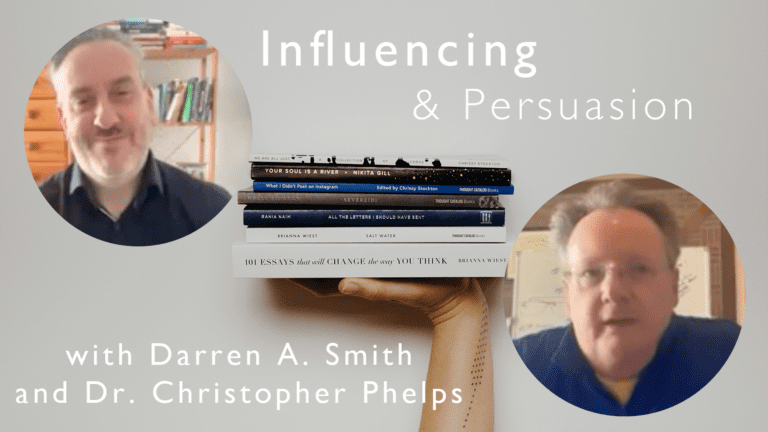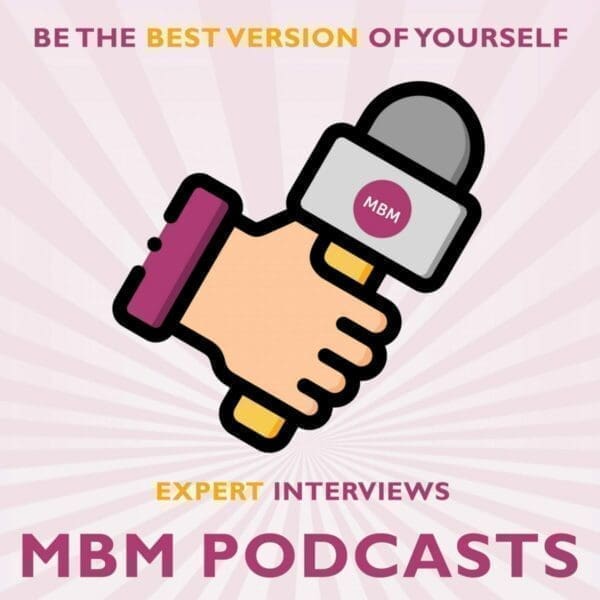Dr. Christopher Phelps Talks Persuasion & influencing with MBM CEO, Darren A. Smith.
Continuing their conversation from previous discussions, Cialdini Institute CEO, Dr. Christopher Phelps chats with Darren about his training under Robert Cialdini, his expertise and experience in persuasion & influencing, and some great recommendations for further-learning resources.

Read the full Persuasion & influencing podcast, part two, below:
Darren A. Smith
Welcome to the world’s stickiest learning. We’re in a podcast with Doctor Chris Phelps. Chris, how are you?
Dr. Chris Phelps
Awesome, how are you doing?
Darren A. Smith
Hey, I’m really good. Now, you were trained and almost the right hand man of Doctor Cialdini. Is that right?
Dr. Chris Phelps
That is correct. I was had the benefit of being able to be personally trained by him.
Spent over a year under his tutelage, so to speak, learning behavioural science, research studies and applying them at the time to my own dental practises.
Darren A. Smith
It was fabulous. OK, so we’ve got the man of the moment for persuasion influencing. We’ve got a whole bunch of Google questions that people search for that we’re going to put to you to see if we can get those answers.
I feel extremely privileged to get you back again because we did a podcast a little while ago. We went off on four or five tangents, which were brilliant. One of the things I remember is you were talking about sales and you said take the pyramid from going up to going down, which was instead of selling the small thing, the medium, the medium thing, the large thing, you go back the other way. Is that right?
Dr. Chris Phelps
Yes. So it’s kind of interesting when it comes to presenting value of something like let’s say you have different options and you want to build value for each of your higher options. So then in that case you do want to present your options from low to high. So the least valuable thing to the most valuable thing, right, the most features, services et cetera. But when it comes to presenting the price of those items.
Darren A. Smith
Yep.
Dr. Chris Phelps
That’s when you want to flip it. You want to start high and work your way down.
And automatically I call it taking them down the stairs.
Going down takes less energy and in contrast, each option seems more and more favourable and in fact not only do more people say yes, your biggest and best option starting high and going low, presenting the price more people tend to say yes to at least one of the other options as well. So more people say yes overall than if you present your price of your items or options going up the stairs.
Darren A. Smith
I’ve just written that down. Taking them downstairs. Love it. Love it. OK, so that’s in the previous podcast. If people want to pick that up, please do. Let’s get into some questions that we’ve searched for on Google. People have asked the six laws of persuasion. Could you take us through those? Maybe one by one or your favourite one. Let’s see what we got time for. What’s your favourite one that helps influence, persuade people.
Dr. Chris Phelps
Oof. I know for me, probably my favourite one is definitely consistency.
It’s actually one of our principles we can use to motivate action today, so it also tends to be kind of handy in situations if you understand how to leverage it and what consistency it basically means. It’s the commitment principle, right? If people make a commitment, if they commit, they tend to do so. If they’re not doing in your world your scenario, then you’re probably not really getting a commitment.
Darren A. Smith
Yep.
Dr. Chris Phelps
That was a big light bulb for me early on when I was learning this in my own businesses.
Why customers weren’t saying yes to our services? Why I kept having to tell my team to do stuff and setting them, just doing it, their job on their own and and other examples. So once I got better at getting commitments, then I could get out of the way and watch the change in people’s behaviour, so to speak. So understanding the commitment principles definitely key.
Darren A. Smith
So could you bring that to life? Because I think everyone out there is going. Yeah. I can’t get my team to do this. I keep chasing them for that. It’s driving me nuts. What would be a practical example?
Dr. Chris Phelps
Yeah. So telling versus commitments. So in a popular restaurant in Chicago, here in the states, they had a no show rate on reservations to the tune of 0% of the people who made a reservation for dinner didn’t show. OK. So it wasn’t that it wasn’t popular. It was a very popular place. It was an authority. It was well known for having great quality food, but yet they still had an issue with people not showing up for these reservations.
What they realised was when they were making the appointments, they would end it by just making a statement.
Or telling them, please call us if you can’t make this appointment.
Click right, OK.
Darren A. Smith
Yeah.
Dr. Chris Phelps
Our recommendation to them was, you know what? Why don’t we make this more of a commitment instead of a statement? To do that, we got to make it a question. We’re gonna get a verbal commitment. Question more now. So they changed it from. Please call us to. Will you please call us if you can’t reservation.
And now they’re looking for the person to say yes, I will.
Darren A. Smith
OK.
Dr. Chris Phelps
So automatically now, because of that verbal commitment that one change, no share rates are up from 0% to 0.
Darren A. Smith
Oh wow, just by that small change.
Dr. Chris Phelps
Just on that small little change. So I would gather that if you’re in the business of telling you should be in the business of asking commitment questions instead.
Darren A. Smith
And and so could you take that into a workplace for us? So I’m working with my team. I can’t get the commitment that I want on a project or something they’ve got to do. OK. Would you take it a bit further for us?
Dr. Chris Phelps
Yeah, I’d say, hey, Darren. So here’s the project. Here’s the scope of what needs to get accomplished. Here’s the deadline. We need this done by.
Are you able to get this done and meet this criteria by this deadline?
Darren A. Smith
Yeah, yeah, yeah. OK, that’s sample as that.
Dr. Chris Phelps
So no, yes.
If you’re not able or start to get behind, will you let me know so that I can get you additional resources to help.
Darren A. Smith
Nice.
Dr. Chris Phelps
Yes, of course. I’ll let you know. OK, great.
I’ll check in next week to see how your progress is so adding in that other bit of accountability is also reinforcing the commitment. I’ll wait and I’ll talk about it every week, OK?
Darren A. Smith
Fabulous. All right, so I understand #, which is the law of commitment, consistency, one of your favourites, what would be the next one after that that floats your boat, your boat?
Dr. Chris Phelps
Well, right now, one of the most influential principles is social proof.
You know, especially in times of uncertainty, people in any level people look to others to show or tell them what to they should do, right.
Darren A. Smith
Yep, Yep.
Dr. Chris Phelps
So you know, if you’re presenting things options to people and.
You’re you know that one of your options, the majority of your customers tend to favour or choose then share that information early on. Now I’m going to go over some options with you. Here’s option one.
Here’s option two. Here’s option three now with option one. Here’s some of the pros and cons. Now, interestingly, this happens to be the one that the majority of our customers choose.
If you have a number to back that up an ethical number meaning a statistic, and here’s what .% of our customers choose.
Darren A. Smith
Yep, Yep.
Dr. Chris Phelps
Let me talk about why then automatically that person is thinking themselves. Oh, that’s what everybody else is picking. That’s probably going to be the safe one for me.
Darren A. Smith
Lovely. Lovely. And that’s why on Amazon, Google Review. Sorry Google, Amazon reviews are so important. Yeah, of course.
Dr. Chris Phelps
Well, and the key with that is if you, you know, showing evidence of what others have done or have said is social proof. But at the same time, we want to make sure there’s new research that shows we want to make that evidence present tense, not just past tense. Right. So if you say I’ve check out these testimonials, check out these reviews.
That implies they’re from the past. Somebody comes to your website and they look at that, they don’t know how current is. That. Is this a review from five years ago and you haven’t had one since?
I mean, in today’s world, we want accurate up to date up-to-the-minute information if possible, right? So instead what studies show is you want to change the tense. If you’re actively getting reviews and testimonials, it’s not. Look at these reviews, it’s check out our what our reviewers say.
It’s not click here to read testimonials, it’s click here to read our testifiers.
Exactly.
Darren A. Smith
Nice. Nice. I like it.
Dr. Chris Phelps
Leveraging evidence of the masses today in this moment, not a Percy pass where we don’t know how long ago that was.
Darren A. Smith
Lovely. OK, OK. Makes perfect sense. Perfect sense. All right.
Just coming back to the questions that people are searching, asking on Google, they’ve asked about principles. They’re asking about the research that was done to back those up. Now I assume it’s over a very long time, but would you just give us a few minutes on what? How did you get to the six laws of persuasion?
Dr. Chris Phelps
Yeah, you know, so flashback 0. Some years ago, Doctor Cialdini’s, a young researcher at Arizona State University looking for a project to kind of make his name on, as most young researchers do. And he’s sitting at his desk, and he’s got this box of chocolate bars sitting in front of them. These are, like, individually wrapped chocolate bars that students at universities and lower level educations would sell for fundraising efforts. OK.
Darren A. Smith
Yeah, yeah, yeah.
Dr. Chris Phelps
So he’s got this entire box that he has now purchased of these Charco bars. And what’s interesting about this to him is that he hates chocolate.
Darren A. Smith
OK.
Dr. Chris Phelps
So he stared at this box going. What just happened? Why did I buy a box of something I hate?
Something triggered me. Something influenced me here, right? But he wasn’t quite sure what, so it got him among many things in his life leading up to this was kind of the final catalyst to go. I need to go out there and see what are the best of the best you’re using to influence us to say yes to that request. So he actually stepped outside of the university and the lab research lab setting and went into the field, into the business world. Right.
Right. And he would change his name. He changed his hair colour, change his outfits. Like he pretended to be a potential sales person in all these different sales training industry. So he went through door to door sales in a sales training process for them for this company he went through.
What we call the Olan Mills photography. So let’s say you’re going to go and you take your family for Christmas to get family photos for a Christmas corn or whatever, and you’ve got a, you know, coupon to get your one photo.
And the next thing you know, you leave with $00 worth of photos.
Darren A. Smith
I should.
Dr. Chris Phelps
It just happened there, right? So the upsell training, if you will, that goes on in those kind of industries he worked in and went through sales training processes for used car dealerships for new car dealerships to see how they influence us to, to want to buy a car. He worked in high end ad agencies in New York and LA to see from a marketing standpoint how people are influencing us to want their product or service. And what I thought was really interesting is he.
Darren A. Smith
Mm hmm.
Dr. Chris Phelps
Kind of surveyed and watched video of cult church leaders.
Across the United States to kind of see how they were influencing people to do a behaviour some of us might find alternative, right and what he was looking across the board was he was looking for patterns. Is there something that everybody is tapping into, whether they realise it or not? OK. And that’s what he discovered. There were six key psychological things, strategies that people were tapping into, but nobody had to find them at that time. Nobody put a name to them.
Darren A. Smith
Yep.
Dr. Chris Phelps
OK. And so that’s what he went back to ASU and decided to do his research on.
And those are what we now know are the six principles of persuasion.
Darren A. Smith
Popular story that this.
All right, all right.
One of the ethical questions that people asked was just because we can learn to persuade people should we, and what are the ethics of once we persuade them that concern people?
Dr. Chris Phelps
Yeah, great question. So you know ethics is kind of funny because it’s kind of subjective, right? It’s it’s up to you. There’s a reason we call it your own personal code of ethics. So when it’s up to you, it’s subjective. That means there’s a spectrum. OK. And you may have some people that think your actions or techniques are ethical. OK, you may have others who may perceive it from their point of view as being unethical.
Darren A. Smith
Yeah.
Dr. Chris Phelps
And you may have some grey area in between, right?
So in a subjective world, how do you know? Should you persuade and tap into these things if they’re present OK?
Well, Doctor Chardini tried to come up with at least three objective criteria for us to use. OK, one of those is simple. As is it true? OK, not kind of true. Not sort of true.
Not semantically true.
But is it the whole truth and nothing but?
Darren A. Smith
Nothing back. Yep.
Dr. Chris Phelps
So if I say I only have two of these available.
And they’re better not be a warehouse full of them across the street.
Right. So that’s what I mean by true. Is it true? OK.
Darren A. Smith
OK.
Dr. Chris Phelps
Is it natural to the situation, right, not contrived, not staged. So what’s cool about these principles is we’re not illegally or imparting them into situations that they’re not already present. OK, we’re using them ethically. They’re already there, available for us to tap into because most people haven’t been trained to recognise which ones are there or what to do with them, right?
So good news is to use these ethically. We’re just tapping into the principles already present. OK, it’s natural to the situation. And then of course, our intent is key. Like, are we really trying to move forward if we get a yes, is it in both our best interests?
Darren A. Smith
OK. Yep, Yep.
Dr. Chris Phelps
Doesn’t mean there won’t be some cost to both sides, but is it a net win win, right? Is it worthwhile? Do the benefits outweigh the cost for both sides? So if we get a yes, then both of us win moving forward and how do you know objectively that’s true? Well, is there some kind of consequence or cost for a no to both sides?
Darren A. Smith
Yeah, I like that. I like that. And it has he. You wrapped a mnemonic around these a way of simply understanding them? I imagine they’re really important principles. How do we how do we keep them in our heads?
Dr. Chris Phelps
Yeah, that’s a good question. But you we don’t have a mnemonic. That’s that’s one thing we are missing.
Yeah, I don’t know. I I just, I know them so well. Just because I’ve studied them for so long. But yeah, I’ll work on that. Maybe there’s some kind of a new moniker. What’s that word? You can make a word out of them as a result.
Or some kind of play off of their words, yeah.
Darren A. Smith
Yeah, yeah, yeah. OK. So. So I took them as. Is it true? Is it naturally present in the situation? And is it in both our interests? Is that broadly it? Yeah. OK. OK. All right, fabulous.
Dr. Chris Phelps
That’s it.
Did you get a? Yes. We both win. If we get a note, we both lose.
Darren A. Smith
Yeah.
Yeah, fair enough. Fair enough. OK.
Let’s take you to the workplace. People who are just average at persuasion and influence.
What three things can they do to improve their influencing ability so half their lives is probably over? Teams like we’re doing here and half their lives is probably in an office face to face with people. Have we got some top tips or things they can learn?
Dr. Chris Phelps
Say obviously, like most situations you gotta make sure you’ve got good relationships with people, right?
So finding time if the relationship isn’t there for one reason or another.
Spend some time dedicated to developing that relationship, so that’s where we use the liking principle. Find some things in in common right. The more connections you have with that person, the more commonalities similarities in your life, hobbies, interests, family, whatever.
The more connected you are, the more likely they are to want to say yes to you and do business with you. OK now so.
Liking is probably the most bungled principle of them all. It’s the most overlooked overstepped because people in this crazy world don’t think they have time right. They’re so rushing trying to get to the end result, they overstep the relationship and it’s costing the everybody billions as a result, right?
In turnover of clients in and having to find new ones and not closing new sales and everything in between. So personal life or business life work on your relationships, OK, work on those connections.
Be the first to give. That’s what reciprocity is all about. If you want a certain behaviour from others, you should be the first to give it first.
Darren A. Smith
Yep.
Yeah, yeah.
Dr. Chris Phelps
‘Cause, we tend to get back what we put out there.
Darren A. Smith
It makes sense when you say it.
And we know this stuff. And then you say we go. Yeah, absolutely. OK. Yep. Got that got that. Yep.
All right, so liking common ground war connection building relationships. If you had a couple of others, if we had three in total, what what else would you advise people out there that what increase their ability to get people to do what they need them to do in the right way?
Dr. Chris Phelps
Yeah.
The next kind of thing they gotta overcome is people’s uncertainty, right? So does this make sense for me? Am I gonna be safe?
Is this gonna work out my favour if I say yes to this thing. OK, so I would caution people on giving people number one. You should be confident in what you’re talking about. OK. If you’re not confident in it. If you think there’s a barrier, if you feel like it’s too expensive, you’re gonna project that when you speak. And when you present it, it’s gonna come out in somebody shape or form. And by default, you’re gonna make that person uncertain.
Darren A. Smith
Yep.
Dr. Chris Phelps
And therefore, they’re not gonna wanna move. OK, so you gotta be confident.
Darren A. Smith
Yeah, love, yeah.
Dr. Chris Phelps
The next thing I would say is you gotta be careful with options.
Darren A. Smith
OK.
Dr. Chris Phelps
Number one, people need a choice. They if they don’t, at least two options. They didn’t really make a commitment. Not really. They were, for they felt kind of forced into it. When you give them things one at a time.
Or potentially could feel coerced into it if you give it to them one at a time. So just by giving it a this or that, which would you prefer automatically, you make more of a choice, and they’re more committed. Now the challenge is this thing called I think.
The book was called the Paradox of Choice. The more options you put in front of people, the less likely they are to pick any of them.
So if you have multiple options to present to them.
My advice is you just gotta be careful. You can’t leave them without a commitment to one of your options, some kind of plan.
Darren A. Smith
OK, OK.
Dr. Chris Phelps
You can’t hope that somebody else is gonna close that for you. Hey, here’s three things. Let me get my sales team to go over the numbers on each of these three things. And then your sales team comes in and goes over three financial options for each of your three service options. The next thing you know, the person’s got nine things they’re trying to choose from.
Darren A. Smith
Yes, minutes.
Dr. Chris Phelps
It’s not going to work.
Darren A. Smith
There’s a wonderful Ted talk I watched many years ago about an older guy who was buying jeans. I don’t know if you’ve seen this and the Ted talk basically says when I was 0, there was two pairs of jeans. Now there’s 0. I don’t know what to buy. So I’ve had the same pair of jeans for 0 years. It’s like, yeah, I get that. Yeah, that that makes sense.
Dr. Chris Phelps
Yeah. Yes, exactly.
Now those those are your two. Make sure you’re confident in what you’re presenting. If there’s any questions around your mind, you’re gonna project that on to the person you’re talking to. And that Third Point, of course, is be careful with the number of options you present. Doesn’t mean you can’t present options, but if you do, you can’t leave them with too many options on the table. You got to get them committed to one plan one. One option. In this case, if you will.
Darren A. Smith
OK.
OK, so you might say which option are you favouring? Which one floats your boat the most or yeah, OK, so they’re saying option looks like the one I’ll probably go for. And you can leave it there. That’s enough for that, yeah.
Dr. Chris Phelps
Yeah. If you not that, you have to make a decision now. But if you were, if you thought about making a decision, are you, which way are you leaning right now based on what you’ve heard those for which one makes the most sense for you, which would you prefer? Oh, I think I like this first option. OK, great. Then I’ll get my team to focus on that first.
Darren A. Smith
Nice.
So I like that. OK, I’m just aware of your time. I’d like to ask you one more question.
Doctor Chilldini was talking on LinkedIn about a rhyme. Now I might have caught you on a spot, but I hope not to. He was talking about when people buy something, if there’s a rhyme in what they’re selling, they’re more confident than it’s right.
Is this something you know?
Dr. Chris Phelps
A little bit. I haven’t seen the full study on that one, but I can totally picture that to be the case and more than anything, it kind of falls under the authority principle. OK, meaning we if somebody took that much time and effort.
Darren A. Smith
OK.
Dr. Chris Phelps
To think it through so that it rhymes.
Darren A. Smith
That makes sense.
Dr. Chris Phelps
And therefore there must be something smart behind it.
Darren A. Smith
OK. OK. That makes sense because I saw him talk for two minutes on LinkedIn video about this rhyme of selling and in a study, people believe that if it had a rhyme, it was twice as likely to be better than this one. And you think, how is that just through a rhyme and you’ve explained it? Wow.
Dr. Chris Phelps
Crazy, right?
Darren A. Smith
Yeah, it is. I’m now trying to think of brands who have rhymes, but I can’t. One doesn’t come to mind as an example, unless you can think of .
Dr. Chris Phelps
No, not not. That comes to the top of mind, you know, but I’m sure there’s a tonnes of companies out there or if not, then there’s a lot of opportunity for companies out there.
Darren A. Smith
Very true. Very true. OK, I’m just going to give you my top takeaways and see if you’ve got any builds on these.
I particularly like what I call the triangle up or down. You’re calling it going, taking them down the stairs. I love that. I love that. We’ve got the three ethical principles around true, naturally present, and both in both our interests. Yeah. Love that. And then we talked to about tips you were talking about more connected in this busy world.
Better relationships. And then I think you talked about confidence projecting that confidence. Do you believe in the thing you’re trying to sell or talk about? And then we talked about options and there’s a paradox of not too many, but maybe – somewhere here is better I think and getting them to commit.
I miss anything.
Dr. Chris Phelps
Yeah, spot on.
And like I said, and you’re really each of those scenarios is hitting upon the main three reasons why people say no to any request. OK, this was research done by one of our our people, doctor Greg Neider, he calls it his core motives model. But in essence the without a relationship, people don’t say yes, right? I don’t know you. I don’t like you. I don’t say yes to you.
There’s any kind of uncertainty at any level, any questions or doubt?
People feel safer to choose to do nothing than to take an action and decide.
And last but not least, if there’s no motivation to act.
It’s not likely to occur, right? So each of those points one hits on each of those, the relationship decrease in their when you’re confident and getting the commitment helps motivate action.
Darren A. Smith
I like those. I like those so they are. So every node that a salesperson gets comes down to probably one of those is what you’re saying.
Dr. Chris Phelps
Or some combination. Sometimes it’s all.
Darren A. Smith
Combination.
Laugh is all of them. You’re really stuffed.
Dr. Chris Phelps
Yeah.
Darren A. Smith
Wow. OK. Chris, fabulous. Thank you. That’s our second podcast on influencing and persuasion. I’ve certainly learnt a lot. Thank you very much. I hope the folks out there have any last tip that you want to share with them either resources or books or something that they can do.
Dr. Chris Phelps
Yeah, yeah, definitely obviously. Check us out at chaldini.com. You can e-mail me at chrischris@childinie.com. Hopefully you can put that in the in the show notes.
And then remember the obviously, if you haven’t read influence of psychology or persuasion by Robert Cialdini, that’s a great place to start. Get the audio book if you’d like to listen to books, what have you. But it’s a good place to start, but just know the book is just scratching the surface on how deep you can go in your knowledge of these things and what you can do to apply these things.
So for those that are really wanna get serious and learn more about this, reach out to us at the Institute. We’ve got all kinds of online video training on demand to help all of you learn more above and beyond what the book offers. So all of you can start having more influence and persuasion in an ethical way in your life.
Darren A. Smith
And the book you mentions, that one there that’s happens to be to your left, is that right? I knew it was there for a reason. All right, Chris. Thank you very much for coming on again. We hope to see you soon. Awesome.
Dr. Chris Phelps
That’s it.
Awesome. Thanks Darren.
Darren A. Smith
Thank you.



